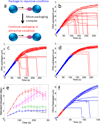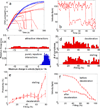Single DNA molecule jamming and history-dependent dynamics during motor-driven viral packaging
- PMID: 27540410
- PMCID: PMC4982518
- DOI: 10.1038/nphys3740
Single DNA molecule jamming and history-dependent dynamics during motor-driven viral packaging
Abstract
In many viruses molecular motors forcibly pack single DNA molecules to near-crystalline density into ~50-100 nm prohead shells1, 2. Unexpectedly, we found that packaging frequently stalls in conditions that induce net attractive DNA-DNA interactions3. Here, we present findings suggesting that this stalling occurs because the DNA undergoes a nonequilibrium jamming transition analogous to that observed in many soft-matter systems, such as colloidal and granular systems4-8. Experiments in which conditions are changed during packaging to switch DNA-DNA interactions between purely repulsive and net attractive reveal strongly history-dependent dynamics. An abrupt deceleration is usually observed before stalling, indicating that a transition in DNA conformation causes an abrupt increase in resistance. Our findings suggest that the concept of jamming can be extended to a single polymer molecule. However, compared with macroscopic samples of colloidal particles5 we find that single DNA molecules jam over a much larger range of densities. We attribute this difference to the nanoscale system size, consistent with theoretical predictions for jamming of attractive athermal particles.9, 10.
Figures



Similar articles
-
Slow and steady wins the race: physical limits on the rate of viral DNA packaging.Curr Opin Virol. 2019 Jun;36:32-37. doi: 10.1016/j.coviro.2019.03.002. Epub 2019 Apr 17. Curr Opin Virol. 2019. PMID: 31003199 Free PMC article. Review.
-
Sticky Matters: Jamming and Rigid Cluster Statistics with Attractive Particle Interactions.Phys Rev Lett. 2018 Nov 2;121(18):188002. doi: 10.1103/PhysRevLett.121.188002. Phys Rev Lett. 2018. PMID: 30444395
-
Repulsive DNA-DNA interactions accelerate viral DNA packaging in phage Phi29.Phys Rev Lett. 2014 Jun 20;112(24):248101. doi: 10.1103/PhysRevLett.112.248101. Epub 2014 Jun 17. Phys Rev Lett. 2014. PMID: 24996111 Free PMC article.
-
Nonequilibrium dynamics and ultraslow relaxation of confined DNA during viral packaging.Proc Natl Acad Sci U S A. 2014 Jun 10;111(23):8345-50. doi: 10.1073/pnas.1405109111. Epub 2014 May 27. Proc Natl Acad Sci U S A. 2014. PMID: 24912187 Free PMC article.
-
Revisiting the genome packaging in viruses with lessons from the "Giants".Virology. 2014 Oct;466-467:15-26. doi: 10.1016/j.virol.2014.06.022. Epub 2014 Jul 3. Virology. 2014. PMID: 24998349 Review.
Cited by
-
Knot formation of dsDNA pushed inside a nanochannel.Sci Rep. 2022 Mar 29;12(1):5342. doi: 10.1038/s41598-022-09242-5. Sci Rep. 2022. PMID: 35351953 Free PMC article.
-
Functional Dissection of a Viral DNA Packaging Machine's Walker B Motif.J Mol Biol. 2019 Nov 8;431(22):4455-4474. doi: 10.1016/j.jmb.2019.08.012. Epub 2019 Aug 30. J Mol Biol. 2019. PMID: 31473160 Free PMC article.
-
Slow and steady wins the race: physical limits on the rate of viral DNA packaging.Curr Opin Virol. 2019 Jun;36:32-37. doi: 10.1016/j.coviro.2019.03.002. Epub 2019 Apr 17. Curr Opin Virol. 2019. PMID: 31003199 Free PMC article. Review.
-
Pressurized DNA state inside herpes capsids-A novel antiviral target.PLoS Pathog. 2020 Jul 23;16(7):e1008604. doi: 10.1371/journal.ppat.1008604. eCollection 2020 Jul. PLoS Pathog. 2020. PMID: 32702029 Free PMC article.
-
Physics of viral dynamics.Nat Rev Phys. 2021;3(2):76-91. doi: 10.1038/s42254-020-00267-1. Epub 2021 Jan 12. Nat Rev Phys. 2021. PMID: 33728406 Free PMC article. Review.
References
-
- Casjens SR. The DNA-packaging nanomotor of tailed bacteriophages. Nature Reviews Microbiology. 2011;9:647–657. - PubMed
-
- Liu AJ, Nagel SR, editors. Jamming and Rheology: Constrained Dynamics on Microscopic and Macroscopic Scales. London, England: Taylor & Francis; 2001.
-
- Trappe V, Prasad V, Cipelletti L, Segre P, Weitz D. Jamming phase diagram for attractive particles. Nature. 2001;411:772–775. - PubMed
Grants and funding
LinkOut - more resources
Full Text Sources
Other Literature Sources
